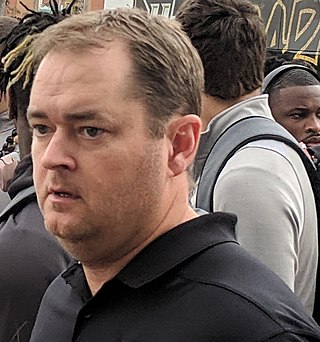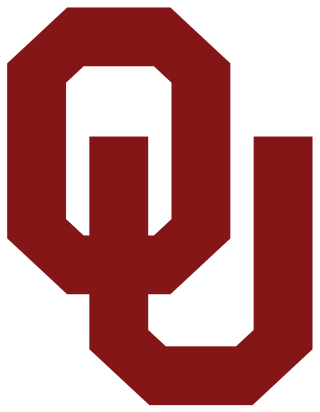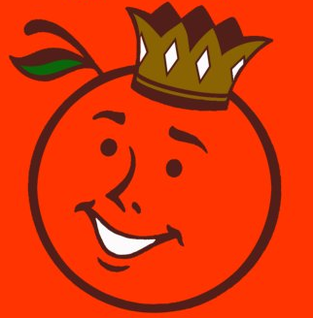Related Research Articles

The Miami Orange Bowl was an outdoor athletic stadium in Miami, Florida, from 1937 until 2008. The stadium was located in the Little Havana neighborhood west of Downtown Miami. The Miami Orange Bowl was considered a landmark and served as the home stadium for the Miami Hurricanes college football team from 1937 through 2007 and for the Miami Dolphins for the Dolphins' first 21 seasons until Joe Robbie Stadium, now Hard Rock Stadium, opened in nearby Miami Gardens in 1987. The stadium also was the temporary home for the FIU Golden Panthers for one year, in 2007, while its on-campus venue, now known as Riccardo Silva Stadium, underwent expansion

Joshua Kenneth Heupel is an American college football coach and former player who is the head football coach at the University of Tennessee. Previously he was head coach at the University of Central Florida, where he compiled a 28–8 record.

The 2000 NCAA Division I-A football season ended with the Oklahoma Sooners beating the defending national champion Florida State Seminoles to claim the Sooners' seventh national championship and their thirty-seventh conference championship, the first of each since the 1988 departure of head coach Barry Switzer.

The Oklahoma Sooners football team represents the University of Oklahoma in college football at the NCAA Division I Football Bowl Subdivision level in the Big 12 Conference. The program began in 1895 and is one of the most successful in history, having won 944 games and possessing a .725 winning percentage, both sixth all-time. Oklahoma has appeared in the AP poll 897 times, including 101 No. 1 rankings, both third all-time. The program claims seven national championships, 50 conference championships, 167 first-team All-Americans, and a record-tying seven Heisman Trophy winners. The school has had 29 former players and coaches inducted into the College Football Hall of Fame and holds the record for the longest winning streak in Division I history with 47 straight victories. Oklahoma is also the only program with which four coaches have won more than 100 games each.

The 1987 Miami Hurricanes football team represented the University of Miami during the 1987 NCAA Division I-A football season. It was the Hurricanes' 62nd season of football. The Hurricanes were led by fourth-year head coach Jimmy Johnson and played their home games at the Orange Bowl. They finished the season 12–0 overall. They were invited to the Orange Bowl where they defeated Oklahoma, 20–14, to win the school's second national championship.
The 1938 Tennessee Volunteers football team represented the University of Tennessee in the 1938 college football season. Head coach Robert Neyland fielded his third team at Tennessee after returning from active duty in the United States Army. The 1938 Tennessee Volunteers won the school's first national championship and are regarded as one of the greatest teams in SEC and NCAA history. The team was named national champion by NCAA-designated major selectors of Berryman, Billingsley, Boand, Dunkel, College Football Researchers Association, Houlgate, Litkenhous, Poling, Sagarin, Sagarin (ELO-Chess)
The 2003 Rose Bowl was a college football bowl game played on January 1, 2003. It was the 89th Rose Bowl game. It was a match-up between the Oklahoma Sooners and the Washington State Cougars. Oklahoma led 27–0 in the fourth quarter and won, 34–14. Sooner quarterback Nate Hybl was named the Player Of The Game.

A national championship in the highest level of college football in the United States, currently the NCAA Division I Football Bowl Subdivision (FBS), is a designation awarded annually by various organizations to their selection of the best college football team. Division I FBS football is the only National Collegiate Athletic Association (NCAA) sport for which the NCAA does not sanction a yearly championship event. As such, it is sometimes referred to as a "mythical national championship".
The 1962 Alabama Crimson Tide football team represented the University of Alabama in the 1962 NCAA University Division football season. It was the Crimson Tide's 68th overall and 29th season as a member of the Southeastern Conference (SEC). The team was led by head coach Bear Bryant, in his fifth year, and played their home games at Denny Stadium in Tuscaloosa and Legion Field in Birmingham, Alabama. They finished season with ten wins and one loss and with a victory over Oklahoma in the Orange Bowl.
The 1938 Oklahoma Sooners football team represented the University of Oklahoma in the 1938 college football season. In their second year under head coach Tom Stidham, the Sooners compiled a 10–1 record, won the school's first Big Six Conference football championship, and outscored their opponents by a combined total of 185 to 29. The team's only loss came in the 1939 Orange Bowl, losing to Tennessee by a 17 to 0 score.
The 1976 Orange Bowl was the 42nd edition of the college football bowl game, played at the Orange Bowl in Miami, Florida, on Thursday, January 1. Part of the 1975–76 bowl game season, it matched the fifth-ranked Michigan Wolverines of the Big Ten Conference and the #3 Oklahoma Sooners of the Big Eight Conference. In the first meeting between these two teams, favored Oklahoma won 14–6.

The 1988 Orange Bowl was the 54th edition of the college football bowl game, played at the Orange Bowl in Miami, Florida, on Friday, January 1. Part of the 1987–88 bowl game season, it matched undefeated teams: the independent and second-ranked Miami Hurricanes and the #1 Oklahoma Sooners of the Big Eight Conference.
The 1985 Orange Bowl was the 51st edition of the college football bowl game, played at the Orange Bowl in Miami, Florida, on Tuesday, January 1. Part of the 1984–85 bowl game season, it matched the fourth-ranked Washington Huskies of the Pacific-10 Conference and the #2 Oklahoma Sooners of the Big Eight Conference. Underdog Washington rallied to win 28–17.
The 1963 Orange Bowl was the 29th edition of the college football bowl game, played at the Orange Bowl in Miami, Florida, on Tuesday, January 1. Part of the 1962–63 bowl game season, it matched the fifth-ranked Alabama Crimson Tide of the Southeastern Conference and the #8 Oklahoma Sooners of the Big Eight Conference. With President John F. Kennedy and First Lady Jacqueline Kennedy in attendance, Alabama shut out the Sooners 17–0.
The 1953 Oklahoma Sooners football team represented the University of Oklahoma during the 1953 college football season. Led by seventh-year head coach Bud Wilkinson, they played their home games at Oklahoma Memorial Stadium in Norman, Oklahoma, and were members of the Big Seven Conference.
The 1959 Orange Bowl featured the Syracuse Orangemen (8–1) and the Oklahoma Sooners (9–1) in the 25th annual Orange Bowl, played on Thursday, January 1, 1959, at the Orange Bowl in Miami, Florida.
The 1987 Orange Bowl was the 53rd edition of the college football bowl game, played at the Orange Bowl in Miami, Florida, on Thursday, January 1. Part of the 1986–87 bowl game season, it matched the ninth-ranked Arkansas Razorbacks of the Southwest Conference (SWC) and the #3 Oklahoma Sooners of the Big Eight Conference. Heavily-favored Oklahoma won 42–8.
The 1986 Orange Bowl was the 52nd edition of the college football bowl game, played at the Orange Bowl in Miami, Florida, on Wednesday, January 1. Part of the 1985–86 bowl game season, it matched the independent and top-ranked Penn State Nittany Lions and the #3 Oklahoma Sooners of the Big Eight Conference. Favored Oklahoma trailed early but won 25–10.
The 1968 Orange Bowl was the 34th edition of the college football bowl game, played at the Orange Bowl in Miami, Florida, on Monday, January 1. The third-ranked Oklahoma Sooners of the Big Eight Conference defeated the Tennessee Volunteers of the Southeastern Conference (SEC), 26–24.
The 2018 Orange Bowl was a college football bowl game played on Saturday, December 29, 2018, at Hard Rock Stadium in Miami. The 85th edition of the Orange Bowl was one of two College Football Playoff semifinal games, the game featured two of the four teams selected by the College Football Playoff Selection Committee—Alabama from the SEC, and Oklahoma from the Big 12 Conference. Alabama took off with a 28-0 lead in the early 2nd quarter and never looked backed to win 45-34. They advanced to face the winner of the Cotton Bowl (Clemson) in the 2019 College Football Playoff National Championship. It was one of the 2018–19 bowl games concluding the 2018 FBS football season. Sponsored by the Capital One Financial Corporation, the game was officially known as the College Football Playoff Semifinal at the Capital One Orange Bowl.
References
- 1 2 3 "Vols Swamp Oklahoma In 17–0 Battle". Pittsburgh Post-Gazette. Associated Press. January 3, 1939. p. 12.
- 1 2 3 "32,191 fans see Tennessee beat Oklahoma, 17-0". Miami News. January 3, 1939. p. 1B.
- ↑ "Camera snaps color, pageantry of Miami's annual Orange Bowl grid classic". Miami News. (photo). January 3, 1939. p. 1.
- ↑ "Vols remain slight favorites over Oklahoma". Miami News. January 2, 1939. p. 1B.